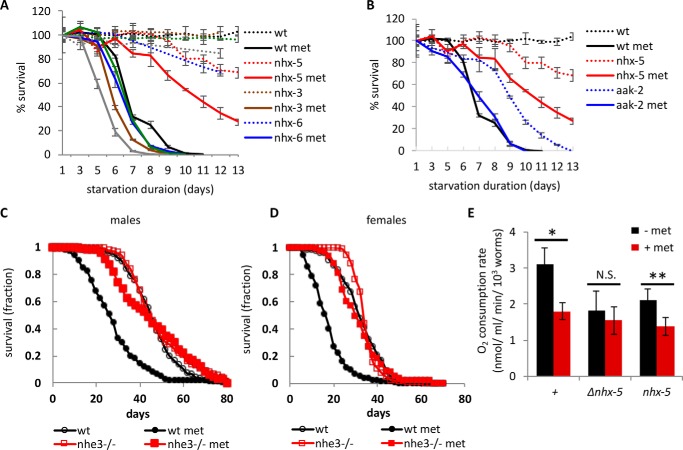FIGURE 2.
The homologs of NHX-5 mediate metformin actions. A, the L1 longevities of all available and viable nhx mutants (nhx-3, nhx-6, nhx-8, and nhx-9) were measured and compared with those of a wild-type control and nhx-5 mutants. L1 longevity in the absence (dotted lines) and in the presence of 100 mm metformin (met) (solid lines) was measured at 20 °C to better distinguish the difference. Each data point is plotted as the average of triplicated samples and standard error. B, the L1 longevities of aak-2(ok524) mutants were compared with those of a wild-type control and nhx-5 mutants. The data of wild-type control and nhx-5 are re-used from panel A. L1 longevity in the absence (dotted lines) and in the presence of 100 mm metformin (solid lines) was measured at 20 °C. C, metformin reduces the lifespan of male flies (black circle). This metformin sensitivity is completely abolished in nhe3KG08307 null mutants (red square). Median survival times were 44 days for wild type (n = 257) without metformin, 26 days with metformin (100 mm, n = 70), and 44 days for nhe3 mutants without (n = 290) or with metformin (n = 276). D, metformin reduces the lifespan of female flies. Median survival times were 32 days for wild type (n = 267) without metformin, 16 days with metformin (n = 275), 34 days for nhe3 mutants without metformin (n = 294), and 30 days (n = 291) with metformin. There was no significant difference in survival between metformin-treated and non-treated nhe3 mutant flies by log-rank test from two independent experiments (p = 0.2 for both sexes, log-rank test), whereas there was significant difference between metformin-treated and non-treated wild-type flies (p < 0.0001, for both sexes). E, metformin affects mitochondrial function in part through NHX-5. The isolated mutants of nhx-5 and an existing deletion mutant of nhx-5 (Δnhx-5) were tested. Approximately 3000 adult worms were treated with 100 mm metformin for 30 min, and the rates of oxygen consumption were measured (see “Experimental Procedures”). Each experiment was done in triplicate, and the experiment was repeated at least three times. N.S., not significant, *, p < 0.05, **, p < 0.01, by paired Student's t test.

